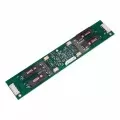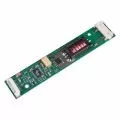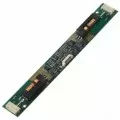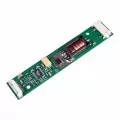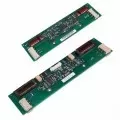OUTLINE:
Something you Need to Know about Air Conditioner Inverter
 251
251Have you ever wondered how you can keep your home cool while saving on energy bills? Are you curious about the latest advancements in air conditioning technology that promise both efficiency and comfort? Look no further!

Image Source:Australian Climate Systems
In this comprehensive guide, we delve into the fascinating world of air conditioner inverters. Discover how these innovative systems can revolutionize your cooling experience and provide essential insights to help you make the best choice for your home.
What Is an Inverter in An Air Conditioner
An inverter in an air conditioner plays a pivotal role in optimizing the system's performance and energy efficiency. At its core, it serves as a sophisticated control mechanism that governs the operation of the compressor motor, a critical component tasked with pressurizing the refrigerant and facilitating its circulation throughout the cooling system.
In contrast to conventional air conditioners that operate in a binary manner, toggling between full power and complete shutdown, an inverter-equipped air conditioner boasts dynamic capabilities.
By continuously monitoring the ambient temperature and the desired cooling level, the inverter intelligently modulates the compressor's speed and output.
This adaptive approach ensures that the air conditioner operates at the precise level required to meet the cooling demand at any given moment, thus eliminating unnecessary energy wastage associated with frequent cycling on and off.
As a result, inverter air conditioners offer unparalleled efficiency, lower operational costs, and enhanced comfort, making them the preferred choice for discerning consumers seeking optimal cooling solutions.
How Does Air Conditioner Inverter Work
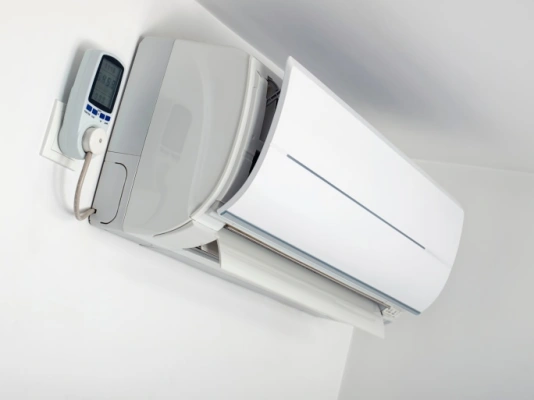
Image Source:Rite Price Heating and Cooling
The operation of an air conditioner inverter revolves around its ability to regulate the speed and output of the compressor motor, the primary component responsible for circulating refrigerant and cooling the air. Here's how the process typically unfolds:
-
Monitoring Temperature: The inverter constantly monitors the temperature of the room or space being cooled through sensors placed strategically within the unit.
-
Adjusting Compressor Speed: Based on the temperature readings and the desired cooling level set by the user, the inverter adjusts the speed of the compressor motor accordingly. Unlike traditional air conditioners, which operate on a simple on/off cycle, the inverter allows the compressor to run at variable speeds.
-
Modulating Power Output: To control the compressor motor's speed, the inverter utilizes a variable-frequency drive (VFD) or electronic inverter controller. This device converts the incoming AC (alternating current) power to DC (direct current) and then back to a variable frequency AC. By adjusting the frequency of the AC power supplied to the compressor motor, the inverter can precisely regulate its rotational speed.
-
Matching Cooling Demand: The compressor motor speeds up or slows down in response to the cooling demand of the space. When the temperature needs to be lowered rapidly, the compressor operates at higher speeds to provide maximum cooling capacity. Conversely, during periods of lower demand, such as when the desired temperature has been reached, the compressor slows down to conserve energy.
-
Continuous Operation: Unlike non-inverter air conditioners, which frequently cycle on and off to maintain the desired temperature, inverter-equipped units operate more consistently. The compressor adjusts its speed smoothly, avoiding abrupt starts and stops, resulting in quieter operation and more stable temperatures.
-
Energy Efficiency: The ability to modulate the compressor's speed based on demand leads to significant energy savings. By avoiding the energy spikes associated with frequent cycling, inverter air conditioners consume less power and operate more efficiently, resulting in lower electricity bills and reduced environmental impact.
What Are the Advantages of An Air Conditioner with An Inverter
Air conditioners equipped with inverter technology offer several advantages over traditional non-inverter models:
-
Energy Efficiency: Inverter air conditioners adjust the compressor speed based on the cooling demand, leading to significant energy savings. By operating at variable speeds rather than constantly turning on and off, they consume less power and maintain a more stable temperature, resulting in lower electricity bills.
-
Fast Cooling and Heating: Inverter technology allows air conditioners to reach the desired temperature more quickly. The compressor can ramp up to full capacity rapidly, providing fast cooling or heating when needed, ensuring immediate comfort upon activation.
-
Precise Temperature Control: With the ability to adjust compressor speed in response to temperature changes, inverter air conditioners provide precise temperature control. They maintain a more consistent indoor temperature without large fluctuations, enhancing overall comfort levels.
-
Quiet Operation: Inverter air conditioners operate more quietly compared to non-inverter models. The compressor adjusts its speed smoothly, resulting in reduced noise levels during operation. This makes them ideal for use in residential settings, where quiet operation is desirable.
-
Extended Lifespan: The reduced stress on components due to gradual compressor speed adjustments can lead to an extended lifespan for inverter air conditioners. With fewer instances of starting and stopping, these units experience less wear and tear, potentially reducing the need for maintenance and repairs.
FAQ: Is an An Air Conditioner with An Inverter Better
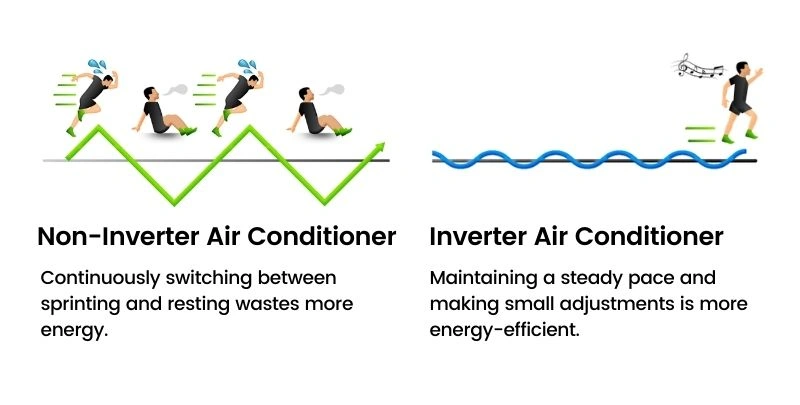
Image Source:Metropolitan Air Conditioning
An air conditioner with an inverter is generally considered superior to traditional non-inverter models for several compelling reasons.
Firstly, inverter air conditioners are highly energy-efficient, adjusting the compressor speed to match the cooling demand, which significantly reduces power consumption and lowers electricity bills.
They also provide faster cooling and heating, as the compressor can operate at higher speeds initially, ensuring immediate comfort.
Additionally, inverter models offer precise temperature control by continuously adjusting the compressor's speed, resulting in a stable and consistent indoor climate.
Their quiet operation, due to the absence of noisy start-stop cycles, makes them ideal for residential use, particularly in bedrooms and living areas.
The gradual ramping up and down of the compressor speed reduces wear and tear on the unit, potentially extending its lifespan and requiring less frequent maintenance.
Moreover, inverter air conditioners are environmentally friendly, consuming less electricity and thereby reducing greenhouse gas emissions.
They also excel in humidity control, maintaining a consistent temperature and creating a more comfortable environment, especially in humid climates.
Lastly, inverter air conditioners are versatile and adaptable, available in various sizes and capacities to suit different applications, from small rooms to large commercial spaces.
While they may have a higher upfront cost, the long-term savings on energy bills, reduced environmental impact, and extended lifespan make them a worthwhile investment.
Therefore, for most users, an air conditioner with an inverter is the better choice.
[For Someone in Need]How to Clean Air Conditioner Inverter
Cleaning an air conditioner inverter is essential for maintaining its efficiency and prolonging its lifespan.
Here's a step-by-step guide for someone in need of cleaning their air conditioner inverter:
Materials Needed:
-
Soft cloth or microfiber towel
-
Vacuum cleaner with a brush attachment
-
Mild detergent or AC cleaning spray
-
Water
-
Fin comb (optional, for cleaning fins)
-
Screwdriver (if needed for removing panels)
Step-by-Step Guide:
1. Turn Off the Power
Ensure the air conditioner is turned off and unplugged to avoid any electrical hazards.
2. Clean the Exterior
Wipe down the exterior of the unit with a soft cloth or microfiber towel to remove any dust or dirt.
3. Remove and Clean the Filters
-
Open the front panel of the air conditioner to access the filters.
-
Remove the filters gently.
-
If the filters are reusable, wash them with warm water and mild detergent. Rinse thoroughly and let them air dry completely before reinserting. If the filters are disposable, replace them with new ones.
4. Clean the Evaporator Coils
-
With the filters removed, you can access the evaporator coils.
-
Use a vacuum cleaner with a brush attachment to remove dust and debris from the coils.
-
For a more thorough cleaning, you can use a mild detergent or a special AC cleaning spray. Apply the cleaner and let it sit for a few minutes, then gently wipe the coils with a damp cloth. Avoid damaging the fins; if they are bent, you can use a fin comb to straighten them.
5. Clean the Condenser Coils (Outdoor Unit)
-
Turn off the power to the outdoor unit.
-
Remove any debris or obstructions around the unit.
-
Use a vacuum cleaner or a brush to clean the condenser coils. You can also use a hose to gently wash away dirt, being careful not to bend the fins.
-
If the coils are very dirty, use a mild detergent or a specialized coil cleaner.
6. Inspect the Drain Pan and Drain Line
-
Check the drain pan for any dirt or mold. Clean it with a mixture of water and mild detergent.
-
Ensure the drain line is not clogged. You can flush it with water to clear any blockages.
7. Check the Fans
-
Clean the fans of both the indoor and outdoor units with a cloth or vacuum cleaner to remove dust buildup. Ensure the fans are free from obstructions and can rotate freely.
8. Reassemble the Unit
-
Once all components are clean and dry, reassemble the air conditioner.
-
Replace the filters and close the front panel securely.
9. Turn the Power Back On
After ensuring everything is properly reassembled and dry, plug the unit back in and turn on the power. Test the air conditioner to ensure it’s working correctly.
The End
Understanding the ins and outs of an air conditioner inverter is key to maximizing its performance and ensuring a comfortable indoor environment.
From its energy-efficient operation to its precise temperature control and quiet operation, the benefits of inverter technology are clear.
By following proper maintenance procedures, such as regular cleaning and professional servicing, you can keep your air conditioner inverter running smoothly for years to come.
Whether you're looking to lower your energy bills, improve indoor comfort, or reduce your environmental footprint, investing in an air conditioner with inverter technology is a smart choice.
With its advanced features and benefits, an air conditioner inverter is not just a cooling solution – it's a cornerstone of modern comfort and efficiency.

Disclaimer: The views and opinions expressed by individual authors or forum participants on this website do not represent the views and opinions of Chipsmall, nor do they represent Chipsmall's official policy.

share this blog to:


